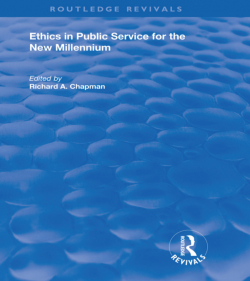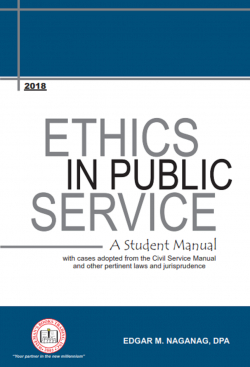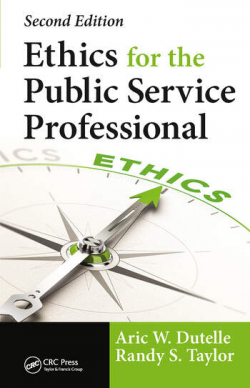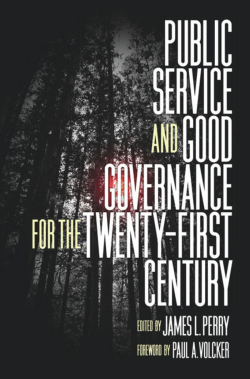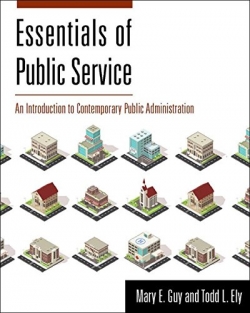Public service ethics: individual and institutional responsibilities
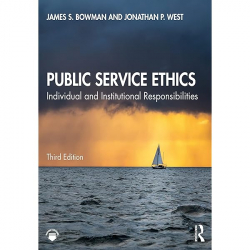
Buy online ($)
Type
Book
ISBN 13
9781032066318
Category
Reference
[ Browse Items ]
Publication Year
2022
Publisher
Routledge, United States
Pages
xix, 411 p.: ill.
Subject
1. Civil service ethics--United States. 2. Public administration--Moral and ethical aspects. 3. Political ethics--United States.
Tags
Abstract
Compared to earlier editions, there remains an even more pressing need to address this vital area of study. Ethics-in all its exemplary and execrable, exhilarating and exhausting forms-matters. It deals with the most gripping question in life: "What is the right thing to do?" As important as it may be to "do things right," it is essential to "do right things." Indeed, regardless of how many things a person does in life, what will be remembered is how he or she responded to ethical challenges. The imperative nature of the topic, then, invites investigation. Since most existing public service ethics books do not report recent research or bring other material up to date, we have expanded our treatment of the subject. The aim is to capture reader interest by featuring in each chapter learning objectives, essential knowledge, skill-building material, telling endnotes, discussion questions, exercises, and appendices.
The intent is to make the narrative user-friendly and accessible by highlighting dilemmas, challenging readers to resolve them, and enticing them to go beyond the text to discover and confront new issues. In so doing, we trust that readers will contact us with their suggestions for improvement in the book (jbowman@fsu.edu; jwest@miami.edu). The ultimate goal is to contribute to student confidence as he or she confronts ethical issues in the future. In so doing, truly "own" this publication by annotating these pages with your ideas, disputes, satisfactions, discomforts, experiences, comparisons, applications, and insights. Then interact with others in a live or virtual classroom to stretch your thinking about the management of ethics and ethics of management.
As in the second edition, Public Service Ethics: Individual and Institutional Responsibilities, Third Edition, introduces readers to this personally relevant and professionally challenging field of study. No matter the topic-the necessity of ethics, intriguing human behavior experiments, provocative approaches to decision-making, new theories to understand ethical actions, the role of ethics codes, whistleblowing incidents, corruption exposés, and the grandeur as well as decay of morality-there is no shortage of controversy. This book discusses these issues, explains how they arise, and suggests what can be done about them. Be advised, however, that it will not, and cannot, provide answers for every case; the study of ethics is not like a cookbook full of recipes.
We have crafted a volume that
• assumes that readers are or will be line managers or technical experts,
• presents a comprehensive range of topics and issues,
• illustrates these discussions with a blend of current events from business, government, and the not-for-profit sectors,
• and encourages students not merely to peruse the material but also to apply it.
As members of the American Society of Public Administration, who have widely published in the field (see "About the Authors"), we believe that while no one is perfect, most people care deeply about ethics and are willing to think about basic issues when given the opportunity. To that extent, all of us are ethicists. Professionals, it follows, need to have not only technical and leadership competencies but also well-honed ethical skills to effectively conduct the public's business. That belief also motivated us to write the type of text described here.
deeply about ethics and are willing to think about basic issues when given the opportunity. To that extent, all of us are ethicists. Professionals, it follows, need to have not only technical and leadership competencies but also well-honed ethical skills to effectively conduct the public's business. That belief also motivated us to write the type of text described here.
The initial chapter-the first of three in Part I that explores the foundations of public service ethics-discusses the multiple rationales for examining ethics. Knowing why one is undertaking an activity is the first step to understanding. New material includes further discussion of the relationship between technical and ethical competence; selected updates on the nature of the market economy, journal-writing guidance, and further documentation; discussion questions; and exercises in this chapter as well as all others.
The second chapter probes multiple frames of reference in comprehending how to study the subject area. This is now augmented with scientific, critical thinking, moral clarity, and moral grandstanding concepts. Additionally, the Green New Deal and Black Lives Matter are referenced, case analysis of the 2017 London Grenfell Towers fire and the Penn State scandal are updated, and pandemic information is provided. The third exploratory chapter defines values and ethics. Fresh information includes references to oaths of office and profiles of Michael Flynn and Alexander Vindman.
With foundations in mind, Part II investigates approaches to ethics. These strategies emphasize individual-centered (cognitive and virtue) schools of thought. To gain a perspective on this material, Chapter 4 focuses on an inclusive and hierarchical theory of moral development that can be applied to individuals and organizations. It also introduces a recent contrasting theory from behavioral ethics that relies on psychological tendencies to explain human conduct. Among the revisions are further analysis of Milgram and Zimbardo experiments, updates on "trolley-ology," as well as discussion of morality pills. Since people do not necessarily make ethically sound choices, Chapter 5 presents a problem-solving strategy that showcases two cognitive decision-making methods: results and rule. More information on moral courage is provided using John Lewis as a compelling illustration. Chapter 6, the third and final individual-premised approach to ethics, turns the discussion from results and rule cognitive philosophies to virtue theory, from "head" to "heart." The theory is further defined in the context of role morality. One exemplary public servant profile, Donna Shalala, is brought up to date and another-Anthony Fauci-replaces an earlier one. As noted, and like other chapters, this one contains new discussion questions, exercises, and/or references for further reading.
Chapter 7 then consolidates the three individual-centered methods to ethics into a tri- partite framework-the ethics triad-that provides a comprehensive tool to analyze difficult work issues. This framework is used to examine selected cases throughout the balance of the book. The chapter also introduces further elaboration of the field of behavioral ethics, which directly challenges the usefulness of traditional views of ethical decision-making such as those found in the triad. This school of thought argues that the prescriptive character of cognitive and virtue ethics does not adequately explain how people really act in ethical situations. Based on experimental and experiential evidence, the claim is that emotion is at least as important as logic-indeed, may be the basis of rationality-in decision-making. This in-depth discussion has been revised and expanded by furnishing discussion of the 2019 Business Roundtable Declaration and behavioral science nudges, plus a new case study and exhibit on the corona virus challenges.
Part III, beginning with Chapter 8, shifts from individual cognitive ("head") and virtue ("heart") ethics to organization-centered (physique or "body") approaches. That is, while the mastery of personally focused ethics explored in Part II is necessary, it is not sufficient for understanding the full scope of ethics, as individual conduct is affected by the environment within which it occurs. The chapter scrutinizes the ethical infrastructure in organizations and is followed by subsequent chapters dealing with corruption control and whistleblowing in institutions. Changes include discussion of inspectors general (IGs), oaths of office, and classroom dishonesty. Chapter 9's revisions on corruption control introduce new material on fraud in government, the roots of corruption, COVID as well as "the other COVID," "drain the swamp," systemically dangerous institutions, gift-giving, plus scandals containing updates on the Flint, Michigan water disaster, the Wells Fargo case, and the Olympic swimming scandal. Chapter 10 on whistleblowing supplies updates as well as new material on normalization of fraud, the importance of how whistleblowing incidents are framed, elaboration on resignations in protest, and a United Nations peacekeeping case.
Selected issues in public service ethics constitute Part IV of the book, with separate chapters on ethics of elected officials, organizational gaming and performance measurement, at-will employment doctrine, and the Hatch Act. These discussions represent a diverse set of topics that illustrate the all-encompassing character of topic area. Chapters 11 and 12, respectively, examine behaviors of political figures and an important dimension of improper institutional conduct, gaming the system. Added are congressional conflicts of interest, alter- natives to lying, incivility, further discussion of "dirty hands," presidential falsehoods, the 2020 elections, the Temple University ranking disgrace, the college admission scandal, and new cases.
Chapters 13 and 14 explore, in depth, two different issues using the ethic triad. The first is the analysis of employment at-will, which is updated to include Donald Trump's 2020 effort to politicize large parts of the civil service. The second is new to this book and examines a related issue, the potential amending of the 1939 Hatch Act.
Part V consists of the closing chapter that serves as a capstone for the text. It emphasizes that all people are ethical agents who have the choice between moral grandeur and decay, and provides guidelines for honorable action in the years ahead. In addition to updates, especially on white-collar crime, coverage of the governmental response to the pandemic, state corruption and anti-corruption measures, democratic governance, the Biden administration, and the American experiment in light of catastrophic climate change are new to this edition.
Each chapter, then, includes case studies drawing on actual and hypothetical events that give students the opportunity to apply the concepts and analytical frameworks in the chapters. Some cases present scenarios that are then followed by questions to consider; others are applied case studies in which we guide the reader through the application of a decision-making framework to show the thought process behind how a decision might be made. Chapters 13 and 14 are the exception, in that the entirety of the chapter is essentially a case analysis. In addition, end-of-chapter discussion questions and exercises give students further opportunity to think more deeply about ethical issues, as well as apply what they have learned.
Welcome to public service ethics in a book whose subject will affect the future of all readers in their careers. And now for the adventure!
James S. Bowman and Jonathan P. West Spring, 2021
The intent is to make the narrative user-friendly and accessible by highlighting dilemmas, challenging readers to resolve them, and enticing them to go beyond the text to discover and confront new issues. In so doing, we trust that readers will contact us with their suggestions for improvement in the book (jbowman@fsu.edu; jwest@miami.edu). The ultimate goal is to contribute to student confidence as he or she confronts ethical issues in the future. In so doing, truly "own" this publication by annotating these pages with your ideas, disputes, satisfactions, discomforts, experiences, comparisons, applications, and insights. Then interact with others in a live or virtual classroom to stretch your thinking about the management of ethics and ethics of management.
As in the second edition, Public Service Ethics: Individual and Institutional Responsibilities, Third Edition, introduces readers to this personally relevant and professionally challenging field of study. No matter the topic-the necessity of ethics, intriguing human behavior experiments, provocative approaches to decision-making, new theories to understand ethical actions, the role of ethics codes, whistleblowing incidents, corruption exposés, and the grandeur as well as decay of morality-there is no shortage of controversy. This book discusses these issues, explains how they arise, and suggests what can be done about them. Be advised, however, that it will not, and cannot, provide answers for every case; the study of ethics is not like a cookbook full of recipes.
We have crafted a volume that
• assumes that readers are or will be line managers or technical experts,
• presents a comprehensive range of topics and issues,
• illustrates these discussions with a blend of current events from business, government, and the not-for-profit sectors,
• and encourages students not merely to peruse the material but also to apply it.
As members of the American Society of Public Administration, who have widely published in the field (see "About the Authors"), we believe that while no one is perfect, most people care deeply about ethics and are willing to think about basic issues when given the opportunity. To that extent, all of us are ethicists. Professionals, it follows, need to have not only technical and leadership competencies but also well-honed ethical skills to effectively conduct the public's business. That belief also motivated us to write the type of text described here.
deeply about ethics and are willing to think about basic issues when given the opportunity. To that extent, all of us are ethicists. Professionals, it follows, need to have not only technical and leadership competencies but also well-honed ethical skills to effectively conduct the public's business. That belief also motivated us to write the type of text described here.
The initial chapter-the first of three in Part I that explores the foundations of public service ethics-discusses the multiple rationales for examining ethics. Knowing why one is undertaking an activity is the first step to understanding. New material includes further discussion of the relationship between technical and ethical competence; selected updates on the nature of the market economy, journal-writing guidance, and further documentation; discussion questions; and exercises in this chapter as well as all others.
The second chapter probes multiple frames of reference in comprehending how to study the subject area. This is now augmented with scientific, critical thinking, moral clarity, and moral grandstanding concepts. Additionally, the Green New Deal and Black Lives Matter are referenced, case analysis of the 2017 London Grenfell Towers fire and the Penn State scandal are updated, and pandemic information is provided. The third exploratory chapter defines values and ethics. Fresh information includes references to oaths of office and profiles of Michael Flynn and Alexander Vindman.
With foundations in mind, Part II investigates approaches to ethics. These strategies emphasize individual-centered (cognitive and virtue) schools of thought. To gain a perspective on this material, Chapter 4 focuses on an inclusive and hierarchical theory of moral development that can be applied to individuals and organizations. It also introduces a recent contrasting theory from behavioral ethics that relies on psychological tendencies to explain human conduct. Among the revisions are further analysis of Milgram and Zimbardo experiments, updates on "trolley-ology," as well as discussion of morality pills. Since people do not necessarily make ethically sound choices, Chapter 5 presents a problem-solving strategy that showcases two cognitive decision-making methods: results and rule. More information on moral courage is provided using John Lewis as a compelling illustration. Chapter 6, the third and final individual-premised approach to ethics, turns the discussion from results and rule cognitive philosophies to virtue theory, from "head" to "heart." The theory is further defined in the context of role morality. One exemplary public servant profile, Donna Shalala, is brought up to date and another-Anthony Fauci-replaces an earlier one. As noted, and like other chapters, this one contains new discussion questions, exercises, and/or references for further reading.
Chapter 7 then consolidates the three individual-centered methods to ethics into a tri- partite framework-the ethics triad-that provides a comprehensive tool to analyze difficult work issues. This framework is used to examine selected cases throughout the balance of the book. The chapter also introduces further elaboration of the field of behavioral ethics, which directly challenges the usefulness of traditional views of ethical decision-making such as those found in the triad. This school of thought argues that the prescriptive character of cognitive and virtue ethics does not adequately explain how people really act in ethical situations. Based on experimental and experiential evidence, the claim is that emotion is at least as important as logic-indeed, may be the basis of rationality-in decision-making. This in-depth discussion has been revised and expanded by furnishing discussion of the 2019 Business Roundtable Declaration and behavioral science nudges, plus a new case study and exhibit on the corona virus challenges.
Part III, beginning with Chapter 8, shifts from individual cognitive ("head") and virtue ("heart") ethics to organization-centered (physique or "body") approaches. That is, while the mastery of personally focused ethics explored in Part II is necessary, it is not sufficient for understanding the full scope of ethics, as individual conduct is affected by the environment within which it occurs. The chapter scrutinizes the ethical infrastructure in organizations and is followed by subsequent chapters dealing with corruption control and whistleblowing in institutions. Changes include discussion of inspectors general (IGs), oaths of office, and classroom dishonesty. Chapter 9's revisions on corruption control introduce new material on fraud in government, the roots of corruption, COVID as well as "the other COVID," "drain the swamp," systemically dangerous institutions, gift-giving, plus scandals containing updates on the Flint, Michigan water disaster, the Wells Fargo case, and the Olympic swimming scandal. Chapter 10 on whistleblowing supplies updates as well as new material on normalization of fraud, the importance of how whistleblowing incidents are framed, elaboration on resignations in protest, and a United Nations peacekeeping case.
Selected issues in public service ethics constitute Part IV of the book, with separate chapters on ethics of elected officials, organizational gaming and performance measurement, at-will employment doctrine, and the Hatch Act. These discussions represent a diverse set of topics that illustrate the all-encompassing character of topic area. Chapters 11 and 12, respectively, examine behaviors of political figures and an important dimension of improper institutional conduct, gaming the system. Added are congressional conflicts of interest, alter- natives to lying, incivility, further discussion of "dirty hands," presidential falsehoods, the 2020 elections, the Temple University ranking disgrace, the college admission scandal, and new cases.
Chapters 13 and 14 explore, in depth, two different issues using the ethic triad. The first is the analysis of employment at-will, which is updated to include Donald Trump's 2020 effort to politicize large parts of the civil service. The second is new to this book and examines a related issue, the potential amending of the 1939 Hatch Act.
Part V consists of the closing chapter that serves as a capstone for the text. It emphasizes that all people are ethical agents who have the choice between moral grandeur and decay, and provides guidelines for honorable action in the years ahead. In addition to updates, especially on white-collar crime, coverage of the governmental response to the pandemic, state corruption and anti-corruption measures, democratic governance, the Biden administration, and the American experiment in light of catastrophic climate change are new to this edition.
Each chapter, then, includes case studies drawing on actual and hypothetical events that give students the opportunity to apply the concepts and analytical frameworks in the chapters. Some cases present scenarios that are then followed by questions to consider; others are applied case studies in which we guide the reader through the application of a decision-making framework to show the thought process behind how a decision might be made. Chapters 13 and 14 are the exception, in that the entirety of the chapter is essentially a case analysis. In addition, end-of-chapter discussion questions and exercises give students further opportunity to think more deeply about ethical issues, as well as apply what they have learned.
Welcome to public service ethics in a book whose subject will affect the future of all readers in their careers. And now for the adventure!
James S. Bowman and Jonathan P. West Spring, 2021
Description
CONTENTS:
PART I FOUNDATIONS OF PUBLIC SERVICE ETHICS
1. Pertinence, Practicality, and Poppycock
2. Perspectives on Ethics: Macro, Meso, Micro
3. Values, Ethics, and Dilemmas
PART II INDIVIDUAL-CENTERED APPROACHES TO ETHICS
4. Moral Development Theory
5. Cognitive Ethics Methods: Result and Rule Problem-Solving Approaches
6. Virtue Theory
7. Conscious Deliberation and Subconscious Action: The Dishonesty of Honest People
PART III INSTITUTIONAL APPROACHES TO ETHICS
8. Organizational Ethics
9. Corruption Control
10. Whistleblowing in Organizations
PART IV ISSUES IN PUBLIC SERVICE ETHICS
11. Ethics and Elected Officials
12. Organizational Gaming and Performance Measurement
13. At-Will Employment
PART V FUTURE HISTORY
15. Choices and Strategies for the Years Ahead
14. To "Re-Hatch" Public Employees or Not?
PART I FOUNDATIONS OF PUBLIC SERVICE ETHICS
1. Pertinence, Practicality, and Poppycock
2. Perspectives on Ethics: Macro, Meso, Micro
3. Values, Ethics, and Dilemmas
PART II INDIVIDUAL-CENTERED APPROACHES TO ETHICS
4. Moral Development Theory
5. Cognitive Ethics Methods: Result and Rule Problem-Solving Approaches
6. Virtue Theory
7. Conscious Deliberation and Subconscious Action: The Dishonesty of Honest People
PART III INSTITUTIONAL APPROACHES TO ETHICS
8. Organizational Ethics
9. Corruption Control
10. Whistleblowing in Organizations
PART IV ISSUES IN PUBLIC SERVICE ETHICS
11. Ethics and Elected Officials
12. Organizational Gaming and Performance Measurement
13. At-Will Employment
PART V FUTURE HISTORY
15. Choices and Strategies for the Years Ahead
14. To "Re-Hatch" Public Employees or Not?
Biblio Notes
Note:
Includes references and index.
Includes references and index.
Number of Copies
2
| Library | Accession No | Call No | Copy No | Edition | Location | Availability |
|---|---|---|---|---|---|---|
| Main | 871 | JF1525.E8 B69 2022 | 1 | Reference Section | Yes | |
| Main | 1171 | JF1525.E8 B69 2022 | 2 | Third Edition | Technical Section | No |
